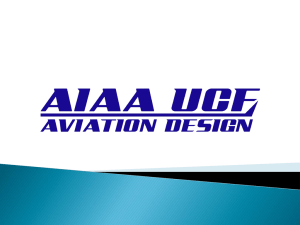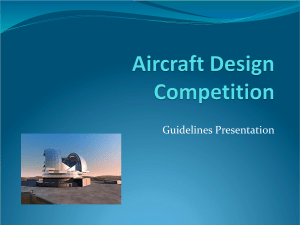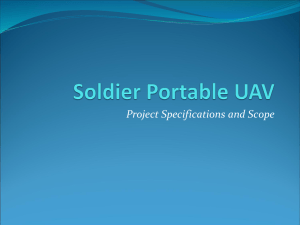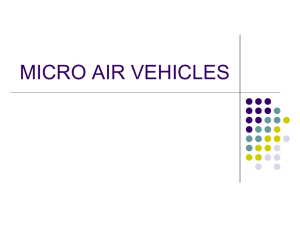Wings & Tailplane
advertisement
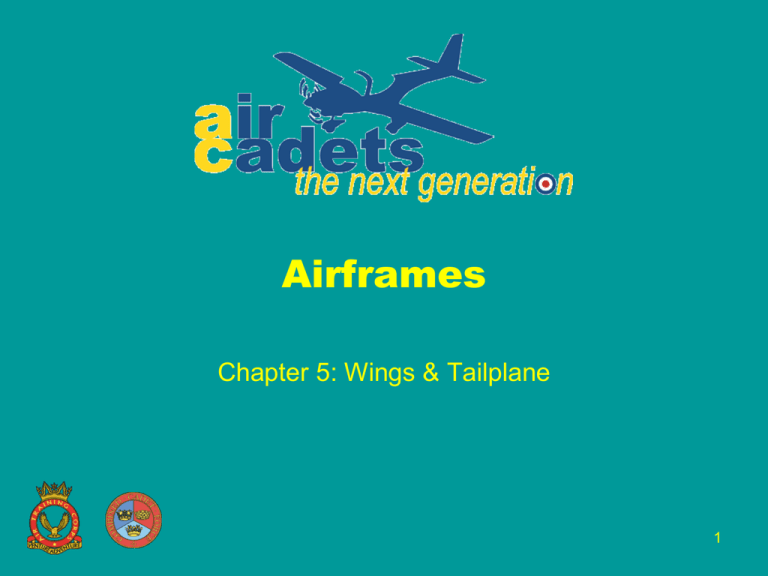
Airframes Chapter 5: Wings & Tailplane 1 2 Learning Objectives The purpose of this chapter is to discuss in more detail, 2 of the 4 major components, the Wing (or mainplane) and the Tailplane. By the end of the lesson you should have an understanding of the main functions of this most important of the main components of an aircraft, as well as it’s construction. But first a recap of Chapter 4 with some questions. 3 Chapter 4 Revision A few questions about the previous chapter. 1. Why are windows elliptical? 2. What is a Welded Steel Truss? 3. Why do we pressurise the fuselage? 4. What parts of a Combat Aircraft are pressurised? 4 The Wing From ‘Principles of Flight’, you will know that to fly, an aircraft must have wings designed to generate lift from the airflow over them. To take off and climb, the wings must produce more lift than the aircraft’s total weight. – For an aircraft such as the Airbus A380, which weighs 550 tonnes, this is no mean task. If a fighter aircraft was to fly in a very tight turn, the wings must then produce lift equal to perhaps eight times the aircraft weight. 5 The Wing For level flight the lift produced must equal the aircraft’s weight. For landing, where the slowest possible landing speed is required, enough lift must be produced to keep the aircraft flying at low speeds. – For this it will normally have special devices added - flaps, leading-edge slats The shape of the aircraft is extremely important, because it dictates how well the aircraft can does its job. For a slow-flying aircraft which needs to lift heavy loads, a large wing is needed, together with a fairly light structure. For fast jets, a much smaller wing is required, and the aircraft will be more streamlined. 6 Wing Loading One of the most important factors in an aircraft design is its wing loading, which is simply its weight divided by its wing area. The weight of the aircraft can vary, both with the load it is carrying and as a result of flight manoeuvres – Flying at 4g in a turn increases an aircraft’s effective weight to four times its normal weight, so its wing loading will change. A useful guide is to use the maximum take-off weight (MTOW) to calculate a ‘standard’ wing loading. Light aircraft will normally have the lowest wing loading, and fast jets the highest, with transport aircraft in between. 7 Design Considerations For aircraft flying at, or near supersonic speeds, the way in which air flows over the aircraft is very different, and can create problems. An aircraft flying quite slowly through the air generates pressure waves, which move at the speed of sound. At speeds near the speed of sound a shock wave forms on the leading parts of the aircraft. The air behind this shock wave becomes turbulent, causing loss of lift, increased drag, changes in trim and buffeting of controls. 8 Sweep-Back – The Solution Designers can reduce the effects of these problems with better designs, particularly swept-back wings. However, these features can cause other problems, because they are more difficult and expensive to build. – Once above the speed of sound, the airflow is steady again, although different to subsonic conditions. The curved shapes that worked well at lower speeds are no longer the most efficient, and straight lines and sharp edges are now preferred. 9 Wing Planform The planform of wings becomes more important than their section, and low aspect ratio and sharper sweepback may be necessary. The main disadvantage of swept-back wings is that they produce much less lift than an un-swept wing of the same area and aspect ratio. – This means that when the aircraft is flying slowly, for instance during landings, a larger angle of attack is required to provide enough lift. This can cause problems with landing gear and in pilot visibility. 10 Swing Wings Being able to change the amount of sweepback in flight would be a way towards getting the best in both situations. This has been done on many high speed military aircraft – In the swept forward position it gives high aspect ratio wing for low-speed performance, allowing tight turns at low speeds and making flaps more effective for take-off and landing. – In the swept back position, it is highly suited to high-speed flight. 11 Delta Wings Another option for aircraft which need to fly at high speeds but also need to be able to turn tightly at all speeds is the delta wing. – This has the advantage of high sweepback, but the trailing edge is more suited to fitting effective flaps. Because of the aerodynamics of delta wings, they are capable of producing lift at much higher angles of attack than other wing shapes, and so can be used on highly agile fighter aircraft. Delta wings, which went out of fashion in the 1970s and 1980s, are becoming more common. Many examples can be seen, often in conjunction with Canard Foreplanes for control. 12 Aspect Ratio The aspect ratio of an aircraft’s wing is an important design feature, and is simply the ratio of the wing span to its average chord. This is not always simple to calculate if a wing shape is complex, so another way of defining it is; 2 Span Aspect Ratio = Area So if a wing has an area of 80 square metres and a span of 20 metres the aspect ratio is (202/80 = 5). It is usual to use the projected area to calculate the aspect ratio, that is, to include that part of the wing which is inside the fuselage. 13 Aspect Ratio - Examples High performance sailplanes have aspect ratios in the region of 25 to 30, and fighters somewhere around 5 to 10. High aspect ratio reduces the induced drag caused by air flowing around the wing tips, and is ideal where long slow flights are required. The drawback is that long, thin wings need to be heavier, and are very flexible. 14 Monoplanes Although there are still a few bi-planes around, most aircraft are monoplanes. This provides a very stiff, strong wing, without the drag penalty of the biplane arrangement. Many light aircraft are braced monoplanes, having a diagonal bracing tie between the wing and fuselage. This allows a lighter structure in the wing, because some of the lift load is taken by the brace. The extra drag caused is acceptable at low speeds. 15 Cantilever Monoplanes The cantilever wing is used for aircraft of all speeds, because it offers the lowest drag. The wings have to be strong enough and stiff enough to carry the whole weight of the aircraft, plus its aerodynamic loads, without the need for external bracing. They can be categorised as; – Low Wing: Grob 115E ‘Tutor’ – Mid Wing: Gen Dyn F-16 – High Wing: BAe Harrier GR9 16 Wing Functions Obviously the primary function of the wings on an aircraft are to provide the lift required to enable it to fly. However, what other functions do you think a wing is expected to do? As you can see, the wing can sometimes do lots of jobs as well as providing lift! 17 Flying Wings So we can see that the wings are the main component of an airframe. In fact, aircraft have been designed and built which consist only of a pair of wings like the Northrop ‘Flying Wing’. 18 Flying Wing Compromise A more common compromise can be seen in aircraft like the Boeing B2 ‘Spirit’ , F-117A ‘Nighthawk’ and delta aircraft like Concorde. 19 Wing Loads & Forces The wing is subject to a number of loads and forces, both whilst the aircraft is on the ground and when it is in the air. – When an aircraft is moving through the air, the ‘drag’ effect from the air to it’s forward motion places a force on the wing. – Likewise, the act of the wing in generating lift also places forces on the structure. – On the ground, the weight of the fuel, undercarriage, engines, wing structure and in military aircraft – weapon loads will all try and bend the wing under the force of gravity. The designer has to make the wings strong and stiff enough to resist not only the forces of lift and drag, which try to bend them upwards and backwards, but also the loads that gravity will place on the structure. 20 Methods of Construction As you have already seen, different sizes and types of aircraft can be constructed in different ways. This applies to the mainplanes, or wings, as much as to any other part. Can you think of component parts of the structure that make up a complete wing? 21 Methods of Construction Each wing is basically made up of two parts; – The internal structure, such as the spars and the ribs – The skin, which can be of fabric, metal or composites. Although the distinction between metal and composite wings may not be very apparent in modern fast jets or large transport aircraft. Wing construction itself comes in two forms. The modern Stress Skin standard and the older Fabric Covered wing. However, both forms of construction rely on a similar internal construction. 22 Fabric Covered Wings The main structural members, as for most aircraft wings, are the front and rear spars, which are attached to each other by a series of ribs. – Ribs give the wing it’s section, and transfer loads from the covering into the spars. Leading Edge Extra Nose Ribs Front Spar Ribs Rear Spar Trailing Edge Attached to the front spar is the leading edge section, in this case made up of nose ribs and the leading edge itself. 23 Fabric Covered Wings The trailing edge section is similar, but of a different shape, and contains the ailerons and flaps. Although the fabric covering takes very little load, it does strengthen and stiffen the structure a little, especially in torsion (twisting). The main structural ribs help to support the fabric to keep a good aerodynamic section along the whole wing. Along the leading edge, where the aerodynamic section curves most, extra nose ribs are added to make sure this important part of the wings is not upset by sagging of the covering fabric. 24 Stressed Skin Wings Air loads on the wing increase at the square of the speed increase. For instance, at 400 knots the air loads are four times as great as the 200 knots achieved by the fastest of light aircraft. – The Eurofighter Typhoon easily reaches speeds in excess of 1200 knots. Fabric covered wings cannot meet these higher loads, and so a more rigid ‘Stressed’ skin must be used. – Aluminium alloys are most often used for this, but composite materials (carbon fibre) are now becoming more common. 25 Stressed Skin Wings Both aluminium alloy and composite provide a smoother finish and more contour to the shape than a fabric covering, but if it is very thin it does not give much extra strength. If the skin is thicker, it can share the loads taken by the structure underneath, which can then be made lighter. Almost all aircraft have their structure made entirely in metal, or a mixture of metal and composite materials. The main spars are still the main strength members, but a large contribution to the strength is made by the skin. 26 Stressed Skin Construction In a Stressed Skin wing, the whole wing is normally of metal construction, although the wing tip, ailerons and leading edge may be of composites. – As the use of composites increase, more and more of the airframe will be made this way. To reduce weight the ribs (both metallic and composite) may have large lightening holes, with flanged edges to keep the required stiffness. The skin may be fixed to the internal structure by rivets and bolts, as shown on the following diagram, or by bonding (gluing), using special adhesives. 27 Stiffening Stringers The stressed wing skin must be stiffened to prevent buckling between the ribs. A simple solution is to add stringers which would be bonded or riveted to them, or integrally machined. Stringers to stiffen the skin 28 Question? So with all that structure, what do you think the space between the front and rear spar could be used for on this type of wing? The volume between the front and rear spars is often used for storing fuel, and holes in the ribs allow the fuel to flow inside this space. 29 Leading & Trailing Edges There are also spaces in the leading and trailing edges i.e. in front of and behind the spars. What do you think could be put in these spaces? Other Equipment The leading- and trailing-edge sections are used for carrying electrical cables, control wires and other items along the wing. 30 So Why Choose Stressed Skin? Stressed skin wing construction is generally chosen as it allows thin cantilever wings to be produced. These are strong enough to resist the tension, compression and twisting loads caused by high speeds. Therefore a wing of stressed skin construction is the ONLY option for an aircraft that travels at medium to high speeds. 31 Spar Design An ideal spar is given depth so it may resist the bending forces that are imposed on it. An example of this is an ordinary measuring ruler, which will flex easily when loaded on its top or bottom surfaces, but is very stiff when a load is applied to the edge. Now you try! 32 Typical Spar Sections Three typical spar sections are shown in pictures below. A & B are made of sections fastened together, but some modern aircraft would have the spar made from a single piece of metal, as in C, making it stronger and lighter. Of course, this means it has to be made more accurately, as no ‘adjustments’ can be made during assembly. Also in examples A and B shown, the flanges could be made as part of the skin, if the skin is machined from a 33 thicker material. High-Speed Flight Spars However, for high-speed flight, a thin wing is needed, but it may not be possible to get a deep enough spar for the wing to cope with the stresses placed upon it. To make the wing strong enough, more than one spar will be used. Using two spars is quite usual on many aircraft and is referred to as a multi-spar wing. 34 Multi-Spar Wing Example Supersonic aircraft, such as the Eurofighter Typhoon, require extremely thin wings, and hence use a multi-spar layout 35 Torsion Box Most modern large aircraft use two main spars, with stressed skin between them, to form a torsion box construction. The example below also has a centre spar. The leading and trailing edge sections are then added in a lighter construction, and carry very little of the loads applied to the wing. The major advantage of this is that, as mentioned earlier, the space within the torsion box is an ideal space to store fuel. 36 Wing Assembly The whole volume is sealed using special compounds to prevent leakage, and may be divided up into several large tanks, so that the fuel may be moved around as required to balance the aircraft or reduce loads in flight. Front Spar The image to the left is of the assembly of an Airbus wide-body wing. Stringers Ribs Centre Spar Easy to see is the front and centre spars (the rear spar is not visible), the ribs and the 37 stringers. Airbus A320 Wing Sub-Assemblies 38 Machined Skin As an alternative to making stressed skins by fastening stringers to the skin (fabricated), the skin, stringers and spar flanges can all be machined from a single piece of alloy, called a billet. This billet may be many metres long, since it is possible to make the skin for one wing in a single piece. The billet is much thicker and heavier then the final machined skin. During the manufacture of the machined skin, up to 90% of the billet will be removed during machining! Although this is more expensive, in both material and machining cost, the final result is a lighter and stronger 39 skin than a fabricated one. Advantages of Machined Skin The advantages of using Machined Skin in an airframe design are; – Riveting is no longer required, so a smoother surface can be achieved – providing a better aerodynamic wing. – The resultant wing has a lighter structure and a more even loading than an equivalent fabricated wing. – Computer-controlled machining means mistakes or faults are less likely, and more easily detected. – Allows for easy inspection during manufacture and in service. – Little or no maintenance is required. – Fuel spaces are easily sealed. 40 Disadvantages of Machined Skin However, there are some disadvantages to utilising Machined Skin in airframes – The associated high cost of manufacturing – particularly the tooling set-up costs – Battle damage repair in combat aircraft with machined skin wings can be more difficult. – Careful design is needed in order to maintain fail safety by limiting spreading of fatigue cracking. 41 The False Spar As they are very different in shape to other types of wing, delta and heavily swept wings have different construction to other wings. Delta wings have a very high chord at the wing root, and so thickness for structural stiffness is not a problem. Swept wings may have to house the undercarriage when it is retracted, and the sweep means that it must be located near to the trailing edge. 42 The False Spar A solution to this is to add another short spar (or false spar) and to increase the chord of the wing at the root. This then gives enough depth in the wing to fit the retracted undercarriage, and provides a strong point for the undercarriage mounting. Centre Spar Front Spar Rear Spar U/C Attachment ‘False’ Spar 43 Undercarriage Attachment Additional Ribs Rear Spar Landing Gear Attachment Points ‘False’ Spar 44 Undercarriage Attachment Rear Spar ‘False’ Spar Landing Gear Attachment Points 45 Tailplane Tailplanes on light aircraft may be built in a similar way to a fabric-covered wing. Stressed-skin tailplanes are usually similar in construction to stressedskin wings, but they are obviously smaller and usually have a different section, because they are not required to produce lift in normal flight. 46 The Fin The picture on the right shows how the fin on a Harrier is constructed. As you can see, the construction of the fin is similar to that of the tailplane. Ribs Stressed skin – The fin consists of ribs, spars and skin panels. Spars 47 Tailplane & Fin Configurations Designers have tried many different configurations of Tailplane & Fin over the years. On the right is the Tailplane & Fin of a Lockheed Super Constellation. – As you can see, instead of a large rudder, it has 3 smaller units. 48 Tailplane & Fin Configurations On large aircraft, the fin may also contain fuel. Not only does this increase the fuel capacity, but it also allows for trimming of the aircraft by transfer of weight rather than by deflecting aerodynamic control surface, and so reduces drag. Another configuration, is the ‘T’ tail – such as the VC-10. – This is where the tailplane is mounted on top of the fin 49 Foreplanes Foreplanes are of similar construction to tailplanes, but are generally smaller in size. – Because of their smaller size, foreplanes lend themselves to being made of composite materials They are almost always ‘all-flying’, that is, the entire foreplane moves to provide the control movements. Typhoon foreplane ‘At Rest’ Typhoon foreplane ‘At Work’ 50 Conclusions As has been seen, the wing is not only the most important part of the airframe, but it is also one of the most complex. As technology advances, so the designers of wings will create evermore efficient wings. Even so, the underlying structure of the wing has not changed in many years. Methods of constructing the wing, and the materials it is made from are the factors that are changing most. Any Questions ? 51 Questions Here are some questions for you! 1. Name 2 parts of a wing? 2. What is an alternative to making a stressed skin by fastening stringers to the skin? 3. If an aircraft increases it’s airspeed from 200 knots to 600 knots, how much higher will the air loads on the wing be? 52

